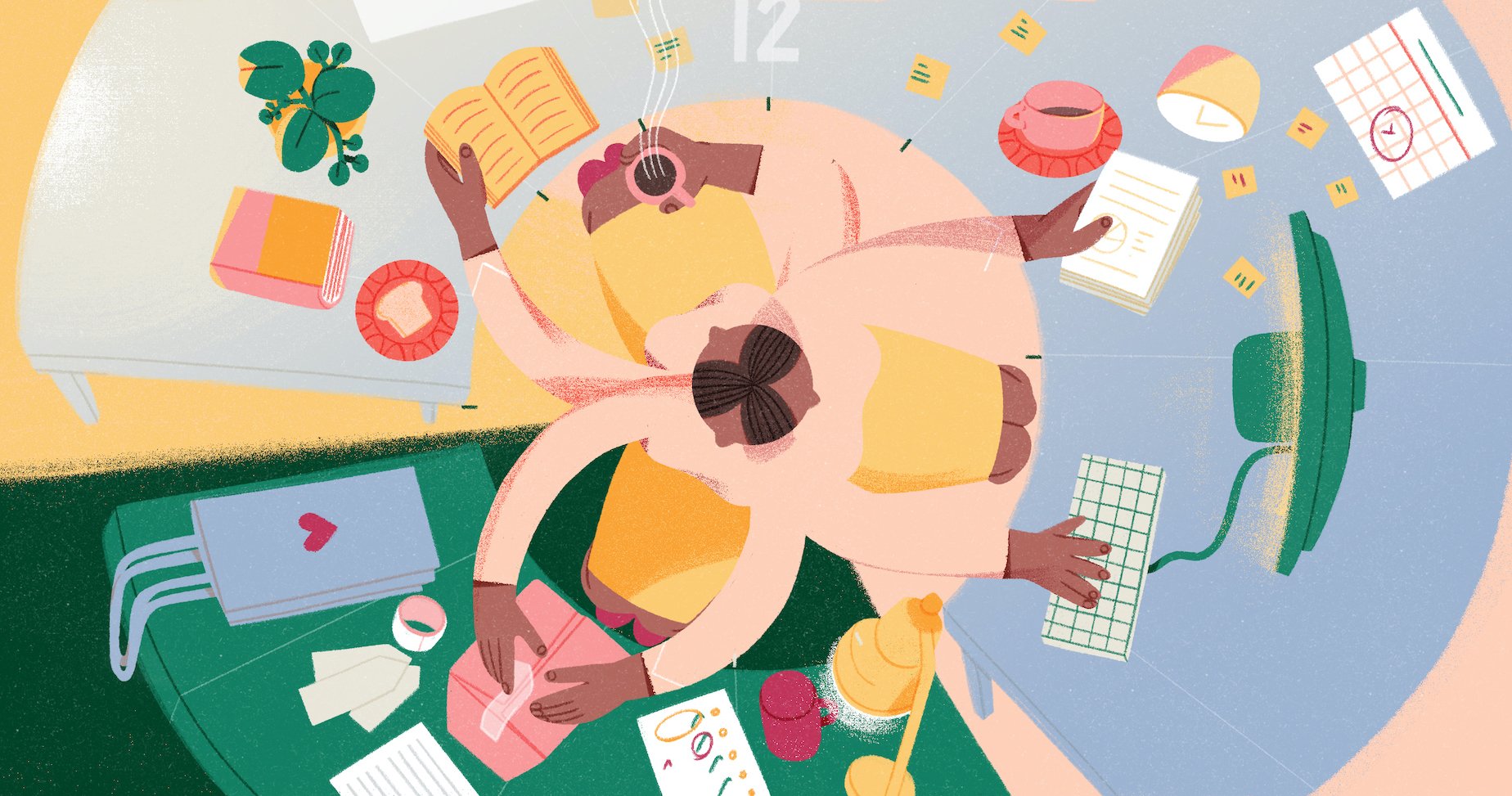How A Side Hustle Can Boost Performance At Your Regular Job
A new study shows that moonlighting lifts your mood—and your effectiveness from 9 to 5.
Moonlighting may actually help you do better at your day job.
Hudson Sessions, an assistant professor in the department of management at the University of Oregon, noticed a few years ago that friends were keeping their full-time jobs but joining the gig economy on the side, such as driving for Uber or selling their art on Etsy.
So, he decided to research the phenomenon of side hustles—and found something surprising. Contrary to the popular wisdom, moonlighting doesn’t leave people worn out and unproductive from 9 to 5. Instead, side gigs can make people feel more empowered—and thereby more productive at the office.
Dr. Sessions and his colleagues—whose results were recently published in the Academy of Management Journal—posted ads on large social-media networking groups, asking people to take a series of surveys about the nature of their supplementary work. Participants were asked about the complexity of their side work; their motives for the work; and the empowerment they did or didn’t gain from their second job (that is, the extent to which they felt that they could control their supplementary work and its context).
The study showed that supplementary work frequently enables side hustlers to feel empowered by taking ownership of self-directed work—which was especially true for those who were motivated beyond making money, says Dr. Sessions.
“When people seek extra work to build relationships or help others, they tend to feel more empowered by their side hustle than if they just moonlighted for more income,” Dr. Sessions says.
In a second study, his team recruited 80 workers who had side hustles and had worked at their day jobs for an average of 10 years. They also recruited a co-worker of each participant.
Across two weeks, the moonlighters filled out a survey about their engagement and empowerment at the end of a day’s side gig. Then, the next morning, at their full-time jobs, they rated their mood and how much they thought about their side hustle. Their co-workers, meanwhile, rated the side hustlers’ performance on those same days.
Side hustlers self-reported that they were preoccupied with their after-hours gigs the next morning, due to being deeply engaged in that work.
That would seem to indicate that side gigs hurt their performance at their regular job the day after. But that wasn’t the whole story: The moonlighters’ colleagues rated their co-workers’ performance significantly higher on those same days.
So, the uplift in mood had a statistically stronger positive effect on employee performance than the negative effect of being distracted—even if the moonlighters didn’t see things that way.
“Organizations want exclusive rights to their employees, but perhaps that idea of ownership is misplaced,” says Dr. Sessions.
He believes that if companies restrict moonlighting, they risk losing employees.
“People need to choose their own path outside of their day jobs,” Dr. Sessions says. “For some, that means pursuing career development, personal fulfilment or just engaging with new and interesting people in a side hustle—all of which can elevate their moods and be beneficial to their regular jobs.”
Reprinted by permission of The Wall Street Journal, Copyright 2021 Dow Jones & Company. Inc. All Rights Reserved Worldwide. Original date of publication: November 1, 2021.
 Copyright 2020, Dow Jones & Company, Inc. All Rights Reserved Worldwide. LEARN MORE
Copyright 2020, Dow Jones & Company, Inc. All Rights Reserved Worldwide. LEARN MORE
This stylish family home combines a classic palette and finishes with a flexible floorplan
Just 55 minutes from Sydney, make this your creative getaway located in the majestic Hawkesbury region.
Impact investing is becoming more mainstream as larger, institutional asset owners drive more money into the sector, according to the nonprofit Global Impact Investing Network in New York.
In the GIIN’s State of the Market 2024 report, published late last month, researchers found that assets allocated to impact-investing strategies by repeat survey responders grew by a compound annual growth rate (CAGR) of 14% over the last five years.
These 71 responders to both the 2019 and 2024 surveys saw their total impact assets under management grow to US$249 billion this year from US$129 billion five years ago.
Medium- and large-size investors were largely responsible for the strong impact returns: Medium-size investors posted a median CAGR of 11% a year over the five-year period, and large-size investors posted a median CAGR of 14% a year.
Interestingly, the CAGR of assets held by small investors dropped by a median of 14% a year.
“When we drill down behind the compound annual growth of the assets that are being allocated to impact investing, it’s largely those larger investors that are actually driving it,” says Dean Hand, the GIIN’s chief research officer.
Overall, the GIIN surveyed 305 investors with a combined US$490 billion under management from 39 countries. Nearly three-quarters of the responders were investment managers, while 10% were foundations, and 3% were family offices. Development finance institutions, institutional asset owners, and companies represented most of the rest.
The majority of impact strategies are executed through private-equity, but public debt and equity have been the fastest-growing asset classes over the past five years, the report said. Public debt is growing at a CAGR of 32%, and public equity is growing at a CAGR of 19%. That compares to a CAGR of 17% for private equity and 7% for private debt.
According to the GIIN, the rise in public impact assets is being driven by larger investors, likely institutions.
Private equity has traditionally served as an ideal way to execute impact strategies, as it allows investors to select vehicles specifically designed to create a positive social or environmental impact by, for example, providing loans to smallholder farmers in Africa or by supporting fledging renewable energy technologies.
Future Returns: Preqin expects managers to rely on family offices, private banks, and individual investors for growth in the next six years
But today, institutional investors are looking across their portfolios—encompassing both private and public assets—to achieve their impact goals.
“Institutional asset owners are saying, ‘In the interests of our ultimate beneficiaries, we probably need to start driving these strategies across our assets,’” Hand says. Instead of carving out a dedicated impact strategy, these investors are taking “a holistic portfolio approach.”
An institutional manager may want to address issues such as climate change, healthcare costs, and local economic growth so it can support a better quality of life for its beneficiaries.
To achieve these goals, the manager could invest across a range of private debt, private equity, and real estate.
But the public markets offer opportunities, too. Using public debt, a manager could, for example, invest in green bonds, regional bank bonds, or healthcare social bonds. In public equity, it could invest in green-power storage technologies, minority-focused real-estate trusts, and in pharmaceutical and medical-care company stocks with the aim of influencing them to lower the costs of care, according to an example the GIIN lays out in a separate report on institutional strategies.
Influencing companies to act in the best interests of society and the environment is increasingly being done through such shareholder advocacy, either directly through ownership in individual stocks or through fund vehicles.
“They’re trying to move their portfolio companies to actually solving some of the challenges that exist,” Hand says.
Although the rate of growth in public strategies for impact is brisk, among survey respondents investments in public debt totaled only 12% of assets and just 7% in public equity. Private equity, however, grabs 43% of these investors’ assets.
Within private equity, Hand also discerns more evidence of maturity in the impact sector. That’s because more impact-oriented asset owners invest in mature and growth-stage companies, which are favored by larger asset owners that have more substantial assets to put to work.
The GIIN State of the Market report also found that impact asset owners are largely happy with both the financial performance and impact results of their holdings.
About three-quarters of those surveyed were seeking risk-adjusted, market-rate returns, although foundations were an exception as 68% sought below-market returns, the report said. Overall, 86% reported their investments were performing in line or above their expectations—even when their targets were not met—and 90% said the same for their impact returns.
Private-equity posted the strongest results, returning 17% on average, although that was less than the 19% targeted return. By contrast, public equity returned 11%, above a 10% target.
The fact some asset classes over performed and others underperformed, shows that “normal economic forces are at play in the market,” Hand says.
Although investors are satisfied with their impact performance, they are still dealing with a fragmented approach for measuring it, the report said. “Despite this, over two-thirds of investors are incorporating impact criteria into their investment governance documents, signalling a significant shift toward formalising impact considerations in decision-making processes,” it said.
Also, more investors are getting third-party verification of their results, which strengthens their accountability in the market.
“The satisfaction with performance is nice to see,” Hand says. “But we do need to see more about what’s happening in terms of investors being able to actually track both the impact performance in real terms as well as the financial performance in real terms.”
This stylish family home combines a classic palette and finishes with a flexible floorplan
Just 55 minutes from Sydney, make this your creative getaway located in the majestic Hawkesbury region.






















